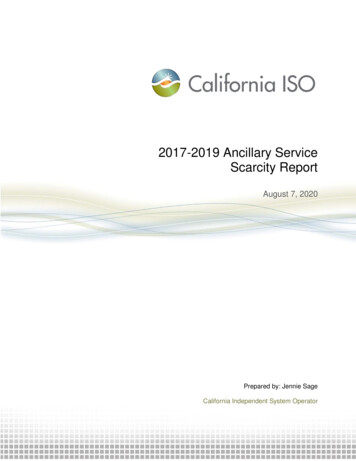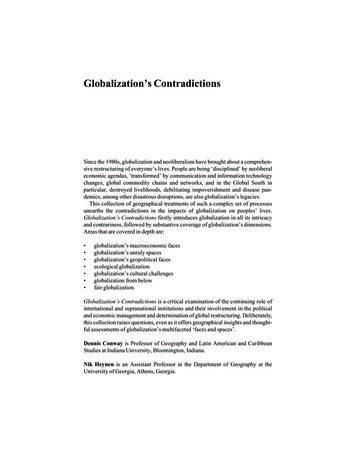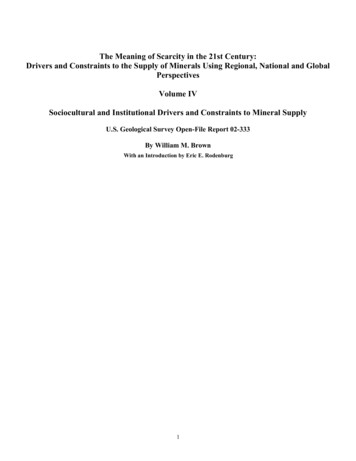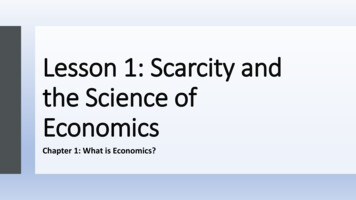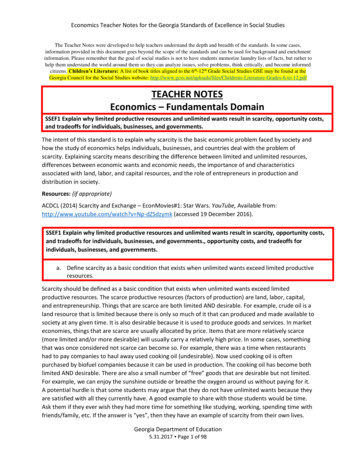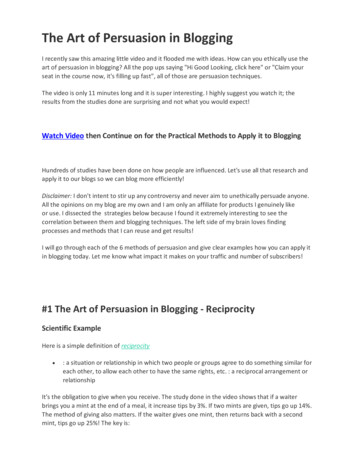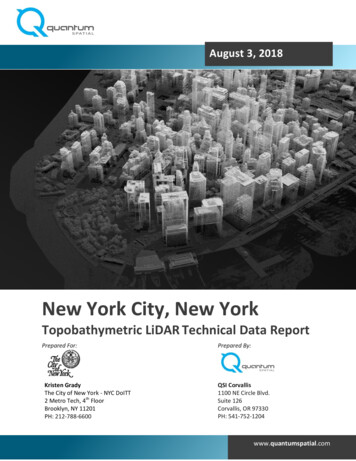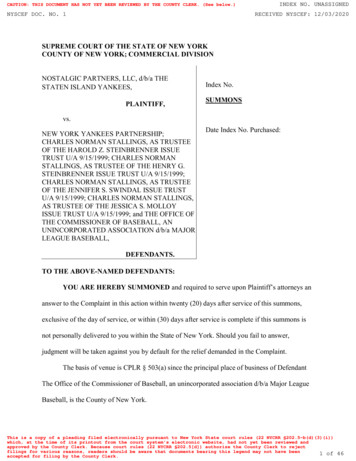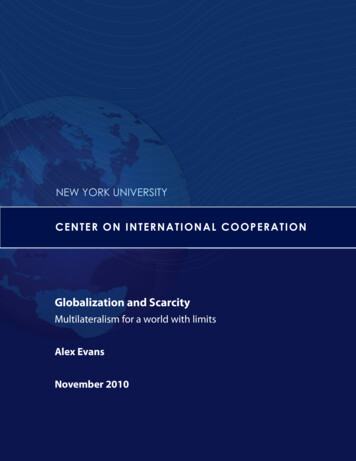
Transcription
NEW YORK UNIVERSITYCEN T E R O N I N T E R N A T I O N A L C O O P E R A T I O NGlobalization and ScarcityMultilateralism for a world with limitsAlex EvansNovember 2010
NEW YORK UNIVERSITYCENTER ON INTERNATIONALCOOPERATIONThe world faces old and new security challenges that are morecomplex than our multilateral and national institutions arecurrently capable of managing. International cooperation is evermore necessary in meeting these challenges. The NYU Center onInternational Cooperation (CIC) works to enhance internationalresponses to conflict, insecurity, and scarcity through appliedresearch and direct engagement with multilateral institutions andthe wider policy community.CIC’s programs and research activities span the spectrum ofconflict, insecurity, and scarcity issues. This allows us to see criticalinter-connections and highlight the coherence often necessaryfor effective response. We have a particular concentration on theUN and multilateral responses to conflict.
Table of ContentsGlobalization and Scarcity Multilateralism for a world with limitsAcknowledgements2List of abbreviations3Executive Summary5Part 1: Into a World of Scarcity10Scarcity Issues: An Overview10Why See Scarcity Issues as a Set?17Part 2: Scarcity and Multilateralism22Development and Fragile States22Finance and Investment28International Trade36Strategic Resource Competition41Conclusion47Endnotes48Bibliography52
AcknowledgementsThis project would not have been possible without the generous financial assistance of the Government of Denmark, whosesupport is gratefully acknowledged.Alex would like to offer his sincere thanks to the Steering Group for the Center on International Cooperation’s programon Resource Scarcity, Climate Change and Multilateralism: the governments of Brazil, Denmark, Mexico and Norway; andWilliam Antholis, David Bloom, Mathew J. Burrows, Helen Clark, Sarah Cliffe, Elizabeth Cousens, Meera de Mel, Geoff Dabelko,David Nabarro, Robert Orr, Bryce Rudyk, Heather Simpson and Josette Sheeran.Grateful thanks also go to Rahul Chandran, Jane Frewer, Richard Gowan, Andrew Hart, Michael Harvey, Bruce Jones, MattKent, Georgios Kostakos, Florian Lux, Michael Mainelli, Nealin Parker, Janos Pasztor, Vera Quina, Elsina Wainwright andConstance Wilhelm for their advice and assistance during this project; and especially to Emma Williams.2Special thanks are due to David Steven, with whom numerous of the ideas in this paper were developed. The paper drawson a number of publications co-authored with David, including Hitting Reboot: Where next for climate change afterCopenhagen? (Brookings Institution, 2009), An Institutional Architecture for Climate Change (CIC, 2009), and The WorldAfter Copenhagen: What can we learn from the geopolitical dynamics of climate negotiations? (CIC, 2010).The paper alsodraws extensively on the analysis set out in Confronting the Long Crisis of Globalization: Risk, Resilience and InternationalOrder (Brookings Institution, 2010, co-authored with David and with Bruce Jones), and on papers commissioned by theoffice of the UN Secretary-General and by the World Bank for the 2011 World Development Report.About the authorAlex Evans directs CIC’s program on Resource Scarcity, Climate Change and Multilateralism. He also works on climate andscarcity issues with organizations including the United Nations, World Bank and Oxfam, and co-edits GlobalDashboard.org,the global risk and foreign policy blog, with David Steven.From 2003 to 2006, Alex was Special Adviser to Hilary Benn MP, then UK Secretary of State for International Development,where he worked across DFID’s policy agenda, focusing in particular on climate change, resource scarcity and multilateralreform.Alex’s previous publications can be downloaded from Global Dashboard.NYUCICGlobalization and Scarcity Multilateralism for a world with limits
List of abbreviationsBRICBrazil, Russia, India and ChinaCAPEU Common Agricultural PolicyCDMClean Development MechanismCEOChief Executive OfficerCGIARConsultative Group on International Agricultural ResearchCNOOCChina National Offshore Oil CorporationCOCarbon dioxideCO2eCarbon dioxide equivalentCSDUN Commission on Sustainable DevelopmentDESAUN Department of Economic and Social AffairsDFIDUK Department for International DevelopmentDPAUN Department of Political AffairsDPIUN Department of Public InformationDPKOUN Department of Peacekeeping OperationsDRCDemocratic Republic of the CongoEIAUS Energy Information AdministrationEITIExtractive Industries Transparency InitiativeEUEuropean UnionFACFood Aid ConventionFAOFood and Agriculture OrganizationGDPGross Domestic ProductGIEWSFAO Global Information and Early Warning SystemGPAFSGlobal Partnership for Agriculture and Food SecurityIEAInternational Energy AgencyIEFInternational Energy ForumIEPInternational Energy ProgramIFADInternational Fund for Agricultural DevelopmentIFPRIInternational Food Policy Research InstituteIMFInternational Monetary FundIPCCIntergovernmental Panel on Climate Changemb/dMillion barrels of oil per dayMDGMillennium Development GoalMITMassachusetts Institute of TechnologymtoeMillion tonnes of oil equivalentNAFTANorth American Free Trade AgreementNGONon-governmental organizationOECDOrganisation for Economic Co-operation and DevelopmentOCHAUN Office for the Co-ordination of Humanitarian AssistanceODAOfficial Development AssistanceOPECOrganization of the Petroleum Exporting Countries23NYUGlobalization and Scarcity Multilateralism for a world with limitsCIC
ppmParts per million (concentration level of CO2 or greenhouse gases)R&DResearch and developmentREDDReducing Emissions from Deforestation and Forest DegradationSADCSouthern African Development CommunitySSMSpecial Safeguard MechanismUNDPUN Development ProgrammeUNEPUN Environment ProgrammeUNFCCCUN Framework Convention on Climate ChangeUNICEFUN Children’s FundUNSGUN Secretary-GeneralUSUnited States (of America)WFPWorld Food ProgrammeWMOWorld Meteorological OrganizationWTOWorld Trade Organization4NYUCICGlobalization and Scarcity Multilateralism for a world with limits
EXECUTIVE SUMMARYGlobalization has improved the living standards ofhundreds of millions of people – but growing resourcescarcity means it risks becoming a victim of its ownsuccess. Left unaddressed, scarcity of food, energy,water, land and other key ‘natural assets’ has the potentialto trigger intensifying zero sum competition betweenstates – in the process, increasing poverty, state fragility,economic instability, inflation, and strategic resourcecompetition between major powers.On food, projections suggest that production will needto increase by 50% by 2030 (and 100% more by 2050), tomeet forecast demand. Yet there are already signs that theproductivity gains of the Green Revolution are running outof steam, even as significant amounts of crops are beingdiverted to biofuels. The 2008 food price spike provideda taste of what may be to come, with the number ofundernourished people rising by over 150 million, unrestin 61 countries and over 30 countries introducing exportbans or restrictions.On land, competition between different land usesis increasing fast – both globally (between land usesincluding food, feed, fuel, forest conservation, carbonsequestration and growing cities), and in hotspotswhere land degradation, desertification, fast growingpopulations and weak systems of land tenure create therisk of political discord or violent conflict.On water, demand will rise by around 25% by 2025, buteven existing consumption levels are already beyondsustainable levels. Water scarcity will intensify over thenext decade as groundwater depletion continues in manyregions. Declining water availability is also projected to beprobably the most significant impact of climate changeover the next decade, with particular impacts on regionsdependent on glacial meltwater and trans-boundaryfreshwater resources.On energy, the International Energy Agency estimatesthat investment of 26 trillion is needed between nowand 2030 to meet projected demand – a figure that risesto 36.5 trillion once the need to reduce greenhouse gasemissions is factored in too. However, current investmenttotals are nowhere near this level, with investment inenergy having fallen particularly fast during the globaldownturn – leading the IEA to warn of the risk of a renewedoil supply crunch as the global economy recovers.Climate change, finally, will intensify all of the abovechallenges, reducing food and water availability, drivingmassive shifts across energy and agricultural systems andcausing a range of other shocks and stresses. A particularchallenge facing policymakers is the fact that climatechange impacts are likely to be highly unpredictable, nonlinear, and hallmarked by sudden shifts as key thresholdsare passed.These scarcity challenges need to be understoodas an integrated whole, not as separate issues. Theyshare common drivers, including both rising demand– driven by a global population projected to reach anestimated 9.2 billion by mid century, and the increasingaffluence of a growing ‘global middle class’ – and furthersigns that the supply of key resources will struggle tokeep pace. All of them present the greatest risk to poorpeople and countries, who have the least capacity to copewith shocks or adapt to new realities. And all of them arelinked together by complex and often poorly understoodfeedback loops, creating the risk of unexpected change,unintended consequences from policy, and multipliereffects that complicate attempts to manage risk.5Scarcity issues could emerge as an important catalystfor collective international action to tackle globalchallenges – in the process helping to ensure that aglobalization that is already efficient also becomesmore sustainable, equitable and resilient. Few observersof the multilateral system would dispute that it is up tothe task of managing scarcity, configured as it is today.But this paper argues that it is already possible to beginassessing the key implications of scarcity issues for a rangeof international agendas; to identify the specific cases inwhich international collective action of reform of existingmultilateral institutions is needed; and to start mappingout the key actions that need to be taken over the short,NYUGlobalization and Scarcity Multilateralism for a world with limitsCIC
medium and longer term. In particular, the paper focusesin on four key policy areas as follows:Development and Fragile StatesClimate change and resource scarcity will hit poor peopleand countries hardest – not only for geographical reasons(e.g. that climate impacts will impact disproportionately onlow latitudes), but also because of their high vulnerability.Environmental shocks are often part of the reason peoplebecome poor in the first place; poor people and countriesspend high proportions of their incomes on food andfuel; the institutional and political weaknesses of fragilestates can make them more susceptible to conflict risksarising from scarcity (although scarcity issues will usuallybe threat multipliers, rather than stand-alone conflict riskdrivers).6Multilateral actors are already massively involved in issuesof development, state fragility and conflict response,and this – together with the fact that poor people andcountries are most vulnerable to scarcity – means thatthe multilateral system will have no choice but to takeaccount of scarcity in its work in developing countries,whether in humanitarian assistance, conflict mediation,peacekeeping, long term development partnership orsupport in international forums.to provide ‘signals from the future’ that can improve longterm predictability for private sector investors; and third,to protect poor people and poor countries from the effectsof scarcity by financing enhanced resilience.International TradeThe food and fuel price spike demonstrated the risk ofacute trade shocks such as price spikes, and how thesecan lead to knock-on social, economic and politicalconsequences. At the same time, such impacts risk leadingto countries losing confidence in open international tradeto ensure their security of supply on key commodities,while in the climate context the potential for unilateraluse of ‘carbon tariffs’ risks leading to a slide towards titfor-tat protectionism. Over the longer term, increasingenergy scarcity or tight emissions controls could impedeinternational supply chains and reduce the overall volumeof international trade.Effective multilateral cooperation can help to head offthese risks by creating trust between countries that theycan rely on the trade system to meet their needs – inthe process, easing security of supply concerns that riskleading to self-fulfilling prophecies as countries act onzero sum competition rather than cooperating to produceopen trade.Finance and InvestmentStrategic Resource CompetitionThe key areas in which investment is needed as a resultof climate change and resource scarcity are (a) energysystems, where the policy challenge is to deliver bothenergy security and climate stabilization at the lowestpossible cost; (b) agriculture, where there is a needto finance increased crop production, again in a waythat addresses climate stabilization, and with far lowerinput levels than today’s agriculture; and (c) the costs offinancing improved resilience (for example, through socialprotection systems), especially in developing countries, inparticular in light of the need to adapt to climate change.Three roles stand out for multilateralism. Collectiveaction is needed, first, to correct market failures, such asenvironmental costs that are not reflected in prices; second,Finally, increasing scarcity will create new strategicresource competition between states – at worst, involvingthe risk of inter-state conflict.158 of the world’s 263international river basins lack any kind of cooperativemanagement framework, with projected glacial meltingan especially important risk driver in the future. Already,both developed and emerging economies are engaged ina scramble for energy resources in numerous regions, anda similar dynamic may be emerging in the context of landand food access deals. Climate impacts, especially risingsea levels, will create new political disputes over newlyavailable resources and sea lanes, whilst challengingexisting legal infrastructure (for example, water sharingagreements). Disputes between states over immigrationNYUCICGlobalization and Scarcity Multilateralism for a world with limits
may become more common if climate change leads to anincrease in migration.Multilateral cooperation is needed not only to containworst case scenarios, such as the risk of inter-state conflictsover resources, but also the risk of a generalized shift awayfrom international cooperation, and towards zero sumcompetition. Given the highly distributed nature of scarcityissues, governments and international organizations willalso need to work collectively to build shared awarenessof scarcity issues among non-state actors, and sharedplatforms that can help to construct political coalitions topush for the international action needed.The paper’s key recommendations in each of these areasare summarized in the table below.SUMMARY OF RECOMMENDATIONSPolicy areaImplications of climatechange and scarcityWhy multilateralism isneededKey multilateral actionsDevelopment and fragilestates Climate change and scarcitycombine with existing sourcesof vulnerability to impact poorpeople and countries hardest Risk of increased poverty, hunger;economic impacts includingreduced growth, higher inflation,worsening fiscal finances,higher interest rates, currencydepreciation New winners and losers; widerimplications for political economyof developing countries Risk of violent conflict (thoughwith scarcity usually as a threatmultiplier rather than a standalone cause) Multilateral institutions alreadymassively involved in issues ofdevelopment and state fragility Poor people and countries will bedisproportionately impacted byclimate change and scarcity Multilateral system will henceincreasingly have to take accountof scarcity issues across the boardin its work in poor countriesShort term Increase internationalhumanitarian assistance capacityand funding Scale up social protectionsystems, safety nets, etc. Build international donor capacityfor analysis of natural resourcegovernance, political economyand conflict risk dimensions ofscarcity Scale up work on girls’ education,access to reproductive healthservices, women’s empowermentand other sectors that can helpreduce unsustainable populationgrowth.7NYUGlobalization and Scarcity Multilateralism for a world with limitsCIC
Policy areaImplications of climatechange and scarcityWhy multilateralism isneededDevelopment and fragilestatesFinance and investment8Medium term Work towards an integratedapproach to building resilienceas part of core developmentstrategies Build scarcity issues into conflictresponse strategiesKey questions and issues Need for more concrete examplesof low-carbon, climate-resilientgrowth Need for integrated assessmentof finance for development needs(see Finance and Investmentbelow) What happens if scarcity developsto the point where socialprotection systems are insufficientfor protecting poor people? Energy infrastructure investmentrequirements of 36.5 trillionbetween now and 2030 Need for a 21st century ‘GreenRevolution’, especially in lowincome countries with highpotential productivity gains –potentially 420 billion betweennow and 2030 Mainstreaming of climateadaptation through developmentstrategies – potentially around 50-100 billion per year from2015 onwards Role of collective action intackling market failures (e.g.environmental costs that areexternalized from current pricesignals) Governments need to provideclear ‘signals from the future’ toimprove long-term predictabilityfor private sector investment Protecting poor people andpoor countries from the effectsof climate change and resourcescarcityNYUCICKey multilateral actionsGlobalization and Scarcity Multilateralism for a world with limitsShort term Pursue key climate adaptation andmitigation actions that can moveforward without a comprehensiveglobal deal Accelerate investment in a 21stcentury ‘Green Revolution’ Scale up R&D spending on bothenergy and agricultureMedium term Move to longer term commitmentperiods and a more robustcompliance regime in globalclimate policy Agree a global climate stabilizationtarget Equitable and binding targets fordeveloping countries within aglobal emissions budgetKey questions and issues Need to reassess finance fordevelopment requirements in lightof scarcity
Policy areaImplications of climatechange and scarcityWhy multilateralism isneededKey multilateral actionsInternational trade Risk of acute trade shocks in food/ fuel contexts Risk of countries losingconfidence in open internationaltrade to ensure their security ofsupply Potential unilateral use of carbontariffs, risking slide into tit-for-tatprotectionism Emission controls or oil scarcitycould drive reductions ininternational trade volumes Role of international institutionsin creating enough trust tosupport the global public goodof open trade (and avoiding tipinto zero sum competition andprotectionism) Current international institutionspoorly configured to cope withscarcity trends (e.g. emergingeconomies not full IEA members,WTO lacks rules on exportrestrictions) Protecting poor people andpoor countries from the effectsof climate change and resourcescarcityShort term Bring emerging economies intofull IEA membership Scaling up food stocks (eitherreal or virtual, at multilateral orregional level) Implement mechanisms to useintergovernmental peer pressureto reduce the risk of export bans orrestrictionsMedium term Move forward with liberalization ofdeveloped country farm supportregimes Agree terms of use for carbontariffs to reduce the risk of ‘climateprotectionism’Key questions and issues What will energy scarcity mean forinternational trade? Will more countries come toregard increased self-sufficiencyas more resilient than reliance onopen markets?Strategic resourcecompetition Risk of increased competitionfor trans-boundary fresh waterresources Risk of inter-state competition forenergy resources Risk of inter-state competition forland, food, biofuels, etc. Impacts of climate change onresource competition, especiallyrising sea levels Potential disputes betweenstates over the fate of ‘climaterefugees’ Risk of overall increase in zerosum competition between statesin international relations Conflict risk arising from scarcitydirectly relevant to UN Charter’sprimary objective of maintaininginternational peace and security Intensifying zero sumcompetition risks erodingexisting internationalcooperation Governments and internationalorganizations need to workcollectively to build sharedawareness of scarcity issuesamong non-state actors, andshared platforms to buildcoalitions for actionShort term Undertake stress testing of existingmultilateral architecture Build up foresight and surpriseanticipation capacities Invest in resilience, e.g. trademeasures as discussed earlier,development policies Start developing options forshared global operating systems tomanage scarcity Commission relevant internationalagencies to produce a joint WorldResources OutlookMedium term Start building up internationalsystem bandwidth and interagency interoperability Develop political narrativescentered on ‘fair shares’, especiallyon food, energy and climate Key questions and issues Will policymakers be ready to takeadvantage of political windows ofopportunity for further-reachingaction as and when they open up?9NYUGlobalization and Scarcity Multilateralism for a world with limitsCIC
Part 1: Into a World of ScarcityThe world is entering an age of scarcity, with climatechange, food security, competition for land and water, andenergy security all moving steadily closer to the center ofthe international agenda. As they do so, they are creatingnew challenges and new concerns in foreign policy. As theFinancial Times’s Martin Wolf observed at the height of thefood price spike“ the biggest point about debates on climatechange and energy supply is that they bring backthe question of limits. This is why climate change andenergy security are such geopolitically significantissues. For if there are limits to emissions, there mayalso be limits to growth. But if there are indeed limitsto growth, the political underpinnings of our worldfall apart. Intense distributional conflicts must thenre-emerge – indeed, they are already emerging –within and among countries.” 110This paper is about what scarcity issues mean forinternational relations – and what they require in terms ofcollective action and multilateral reform.It begins by looking briefly at the key scarcity issues: food,land, water, energy and climate change. Climate changeis regarded as a scarcity issue not only because it is thekey driver of change on the other three, but also because‘airspace’ for human-caused greenhouse gas emissionsis itself an increasingly scarce resource – with just asmuch potential to create zero sum disputes as any of theothers. (Other natural resource issues, such as forestry andfisheries, are omitted from the paper’s analysis for reasonsof space – but many of the arguments made in this paperwould also apply to them.)The paper then sets out why these scarcity trends need tobe regarded as an interconnected whole, noting that theyshare both common drivers – a rising global population,growing affluence, increasing limits to supply growth –and a web of complex feedback loops of knock-on effectsfrom one scarcity issue to another.Finally, the paper looks at what these issues mean forinternational relations more broadly, in particular theareas of development and fragile states; internationaltrade; financing and investment; and inter-state strategicresource competition.Across all of these areas, the paper argues that effectivemultilateral cooperation is essential – not only to buildresilience to the likely effects of scarcity, but also to coordinate the collective action needed to stabilize the rootcauses of resource scarcity and shift the world to a moresustainable trajectory.Scarcity Issues: An OverviewFoodThe food price spike that peaked in 2008 pushed the globaltotal of undernourished people over a billion for the firsttime, from a total of 854 million before the spike.2 With oilprices spiking at the same time, 61 countries experiencedpolitical unrest, in many cases violent; more than thirtyimposed food export bans or restrictions.3More recently, the summer of 2010 saw unpleasantreminders of the events of two years earlier. Wheat pricessaw their biggest one month jump in over three decadesfollowing a severe drought in Russia, and rose still furtherfollowing Russia’s decision to ban exports of the crop; inMozambique, a 30% rise in bread prices triggered riotsthat left seven dead and 288 wounded.4Concerns about a repeat of 2008 appear overdone – theInternational Grains Council points out that the worldis in fact on course for the third highest wheat crop onrecord in 2010 – but the volatile summer had the effectof refocusing political and media attention on the issue offood prices, and on the long term challenge of feeding aworld of nine billion.5 So what drove the food price spike –and should policymakers expect a repeat?As many commentators and analysts have observed sincethe food price spike, the period of 2006 to 2008 was inmany ways a ‘perfect storm’.6NYUCICGlobalization and Scarcity Multilateralism for a world with limits
As Figure 1 below shows, the Food and AgricultureOrganization’s benchmark Food Price Index rose by 9%during 2006, by 24% during 2007 and by 51% during thetwelve months to July 2008.7Among the key drivers of the food price spike werehistorically low stock levels(food reserves declined fromover 110 days’ worth just before 2000, to just over 60days’ worth by 2004); poor weather in important producercountries; and high oil prices (which pushed up costs fortransportation and for inputs like fertilizer).8As prices approached their peak, a range of positivefeedback loops driven by the perceptions of consumers,investors and governments had the effect of amplifyingthe crisis. As already noted, over 30 governmentsimplemented food export bans or restrictions in attemptsto calm domestic political pressures over food prices –pushing food prices higher at the same time as reducingincentives for producers to increase output. At the sametime, many import dependent countries tried to rebuildtheir stock levels, pushing prices higher still. 9Figure 1: FAO Food Price Index, 1990-2010 (source:Food and Agriculture Organization)10changing diet patterns of a growing middle class and alarge increase in biofuels production in the US and the EU,driven by government subsidies and regulatory mandates.Looking to the future, the World Bank suggests thatdemand for food could grow by 50% by 2030, even beforebiofuels are taken into account.11Yet the yield increases driven by the 20th century GreenRevolution appear to be running out of steam, with averageproductivity growth rates falling from 2.0% between 1970and 1990 to 1.1% between 1990 and 2007, and furtherfalls projected in the future.12 The US Department ofAgriculture’s Economic Research Service observed in 2008global demand for grain outstripped supply for seven of theeight years between 2000 and 2008.13 In future, the supplyside also appears likely to be increasingly constrained bythe other scarcity issues discussed in this section, namely: Lower water availability–likely to be the mostimportant scarcity issue affecting food production in theshort term;11 Competition for land–given that the amount of arableland available globally has fallen from 0.39 hectares percapita in 1960 to 0.21 hectares in 2007; 14 Rising oil prices–which will make inputs andtransportation more expensive while increasing theattractiveness of biofuels; and Climate change–which is projected to have a negative impact on crop yields in most developing countriesmore or less immediately (and in all countries over thelonger term), will expose tens of millions more people tothe risk of hunger, and which will greatly complicate thechallenge on each of the three scarcity issues previouslymentioned.15LandBut a range of underlying structural drivers was alsoinvolved, and it is here that the reasons for fears aboutlonger term global food security become apparent.Demand for crops is rising sharply, not only because of anexpanding global population, but also as a result of theBefore the 20th century, additional demand for food wasmet almost entirely through increasing acreage – theamount of land under cultivation – rather than throughenhancing the crop yield from each hectare in production.NYUGlobalization and Scarcity Multilateralism for a world with limitsCIC
During the 20th century, this dynamic reversed, withincreasing crop yields the key driver that allowed foodproduction to keep pace with a rising global population.In the 21st century, however, many analysts suggest thatmeeting food needs will once more require more land tobe brought into food production.16The problem, however, is that growing global demand forfood is by no means the only source of increasing demandfor land. Land is also needed for: feed for the world’s livestock industry, which isconverted into meat (demand for which is projected togrow by 85% by 2030, according to the World Bank) anddairy products, both of which are proportionally muchmore resource-intensive than direct consumption ofcrops;1712 crops to use as biofuels, which accounted for almosthalf the increase in the consumption of major food cropsin 2006-07, according to the International Monetary Fund(primarily as a result of corn-based ethanol pr
the global risk and foreign policy blog, with David Steven. From 2003 to 2006, Alex was Special Adviser to Hilary Benn MP, then UK Secretary of State for International Development, where he worked across DFID's policy agenda, focusing in particular on climate change, resource scarcity and multilateral . reform.
